Related Research Articles

The Muslim period in the Indian subcontinent or Indo-Muslim period is conventionally said to have started in 712, after the conquest of Sindh and Multan by the Umayyad Caliphate under the military command of Muhammad ibn al-Qasim. It began in the Indian subcontinent in the course of a gradual conquest. The perfunctory rule by the Ghaznavids in Punjab was followed by Ghurids, and Sultan Muhammad of Ghor is generally credited with laying the foundation of Muslim rule in Northern India.

Mir Qamar-ud-din Khan Siddiqi also known as Chin Qilich Qamaruddin Khan, Nizam-ul-Mulk, Asaf Jah and Nizam I, was the first Nizam of Hyderabad.
Nawab is a royal title indicating a ruler, often of a South Asian state, in many ways comparable to the western title of Prince. The relationship of a Nawab to the Emperor of India has been compared to that of the Kings of Saxony to the German Emperor. In earlier times the title was ratified and bestowed by the reigning Mughal emperor to semi-autonomous Muslim rulers of subdivisions or princely states in the Indian subcontinent loyal to the Mughal Empire, for example the Nawabs of Bengal.

Nizam of Hyderabad was the title of the ruler of Hyderabad State. Nizam is a shortened form of Niẓām ul-Mulk, and was the title bestowed upon Asaf Jah I when he was appointed Viceroy of the Deccan by the Mughal Emperor Farrukhsiyar. In addition to being the Mughal Viceroy (Naib) of the Deccan, Asaf Jah I was also the premier courtier of the Mughal Empire until 1724, when he established an independent realm based in Hyderabad, but in practice, continued to recognise the nominal authority of emperor.

Kurnool is a city in the state of Andhra Pradesh, India. It formerly served as the capital of Andhra State (1953–1956). The city is often referred to as "The Gateway of Rayalaseema". Kurnool is also famous for Diamond hunting as diamonds can be found in the barren land of Kurnool after the top layers of soil are washed away by the monsoon rains. It also serves as the district headquarters of its Kurnool district. As of 2011 census, it is the fifth most populous city in the state with a population of 484,327. It is located on the banks of the Tungabhadra river. Although the area has been inhabited for thousands of years, modern Kurnool was founded in the 16th century CE with the construction of the Konda Reddy Fort.

Mirza Aziz-ud-Din Muhammad, better known by his regnal name Alamgir II, was the fifteenth Mughal emperor from 1754 to 1759. He was the son of Jahandar Shah.

Shuja-ud-Daula was the third Nawab of Oudh and the Vizier of Delhi from 5 October 1754 to 26 January 1775.

Ahmad Shah Bahadur, also known as Mirza Ahmad Shah or Mujahid-ud-Din Ahmad Shah Ghazi, was the fourteenth Mughal emperor, born to Emperor Muhammad Shah. He succeeded his father to the throne in 1748, at the age of 22. When Ahmed Shah Bahadur came to power, the Mughal Empire started to decline. Furthermore, his administrative weakness eventually led to the rise of the usurping Imad-ul-Mulk.

Asaf Jah VI, also known as Sir Mir Mahboob Ali Khan Siddiqi, was the sixth Nizam of Hyderabad. He ruled Hyderabad State, one of the princely states of India, between 1869 and 1911.

Muhyi ad-Din Muzaffar Jang Hidayat was the third Nizam of Hyderabad from 1750 until his death in 1751. He was also given a very pompous title like his predecessor and rival Nasir Jung; it was Nawab Khan Bahadur, Muzaffar Jung, Nawab Subadar of the Deccan. He became famously known as Muzaffar Jung.
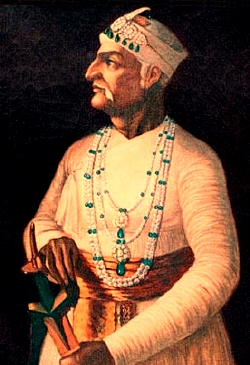
Mir Nizam Ali Khan Siddiqi, Asaf Jah II was the 5th Nizam of Hyderabad State between 1762 and 1803. He was born on 7 March 1734 as fourth son to Asaf Jah I and Umda Begum. His official name is Asaf Jah II, Nizam ul-Mulk, Nizam ud-Daula, Nawab Mir Nizam 'Ali Khan Siddiqi, Fateh Jang, Sipah Salar, Nawab Subedar of the Deccan. Sawānih-i-Deccan, a Persian work compiled by Munim Khan, a military commander during the era of Asaf Jah II gave more insight about administration of Asaf Jahis.
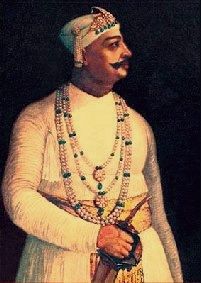
Sikander Jah, Asaf Jah III, was the 3rd Nizam of Hyderabad, India from 1803 to 1829. He was born in Chowmahalla Palace in the Khilwath, the second son of Asaf Jah II and Tahniat un-nisa Begum.

Mir Farqunda Ali Khan commonly known as Nasir-ud-Daulah, was seventh Nizam of Hyderabad, a princely state of British India, from 24 May 1829 until his death in 1857.
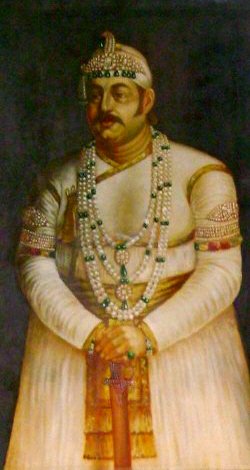
Afzal ad-Dawlah, Asaf Jah VMir Tahniyat Ali Khan Siddiqi was the eighth Nizam of Hyderabad, India, from 1857 to 1869.
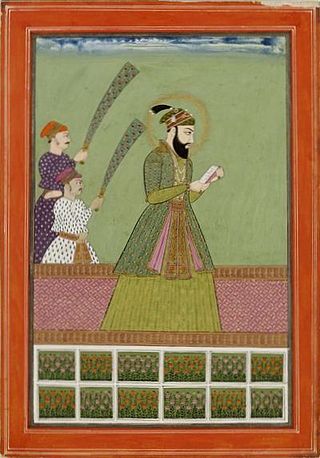
Mir Ahmad Ali Khan Siddiqi Bayafandi, Nasir Jung, was the second Nizam of Hyderabad State. He was the son of Asaf Jah I and his wife Saeed-un-nisa Begum. He was born 26 February 1712. He had taken up a title of Humayun Jah, Nizam ud-Daula, Nawab Mir Ahmad Ali Khan Siddiqi Bahadur, Nasir Jung, Nawab Subadar of the Deccan. However, he is most famously known as Nasir Jung.
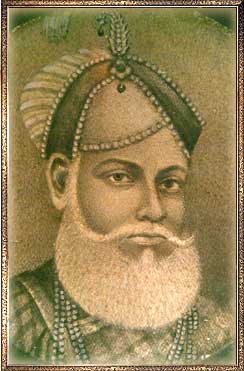
Anwaruddin Khan, also known as Muhammad Anwaruddin, was the first Nawab of Arcot. He belonged to a family of Qannauji Sheikhs. He was a major figure during the first two Carnatic Wars. He was also Subedar of Thatta from 1721–1733.
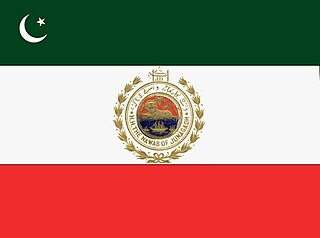
Junagarh or Junagadh was a princely state in Gujarat ruled by the Muslim Babi dynasty in India, which acceded to the Dominion of Pakistan after the Partition of British India. Subsequently, the Union of India annexed Junagadh in 1948, legitimized through a plebiscite held the same year.
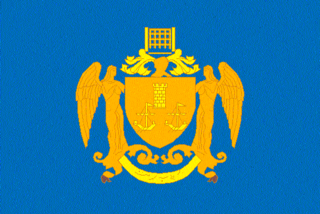
Khambhat state or Cambay state was a princely state in India during the British Raj. The city of Khambhat in present-day Gujarat was its capital. The state was bounded in the north by the Kaira district (Kheda) and in the south by the Gulf of Khambhat.
Mir Gowhar Ali Khan Siddiqi, commonly known as Mubarez-ud-Daulah was a member of the Asaf Jahi dynasty of Hyderabad State. A son of Nizam Sikandar Jah, he was influenced by the Wahhabi movement and wanted to overthrow the East India Company and defeat his elder brother and Nizam Nasir-ud-Daulah. However, his plans were intercepted by Resident James Stuart Fraser and he was arrested by the Nizam.
Turkic peoples have historically been associated as one of the non-native peoples to have ruled areas of the Indian subcontinent. Various dynasties of the later medieval era and early modern era in India were of Turkic and mixed Indian or Afghan descent. Two of the dynasties of the Delhi Sultanate, viz. the Tughlaqs and Khaljis, for instance, were of mixed Turkic origin, with Indian and Afghan ancestry respectively. The terms Indo-Turkic or Turco-Indian is used to refer to people and dynasties of mixed Turkic and Indian descent, as well as the fusion culture formed as a result.
References
- 1 2 3 Mallampalli, Chandra (29 June 2017). A Muslim Conspiracy in British India?. Cambridge University Press. ISBN 978-1-107-19625-4.
- ↑ Cahoon, Ben. "Indian Princely States K-Z".
- 1 2 Raju, P. Yanadi (2003). Rayalaseema During Colonial Times: A Study in Indian Nationalism. Northern Book Centre. ISBN 978-81-7211-139-7.
- ↑ "Wahab Khan tomb in Kurnool to get a facelift". The Hindu. 2 July 2013 – via www.thehindu.com.
- 1 2 3 Seshan, KSS (10 June 2017). "Mubarez-ud-Daulah's era: Of passion, rebellion and conspiracy". The Hindu . Retrieved 3 April 2019.
- ↑ Mallampalli 2017, p. 62.
- ↑ Mallampalli 2017, p. 59.
- ↑ "Bonhams : A silver seal made for Ghulam Rasul Khan Bahadur, Nawab of Kurnool (reg. 1823-39) South Deccan, dated AH 1239/AD 1823-24". www.bonhams.com.
- ↑ Ahamed, Syed Naseer (28 November 2017). "Nawab of Kurnool Ghulam Rasool Khan A Great Freedom Fighter of India who fought against the British Empire".
- ↑ Michell, George; Zebrowski, Mark (10 June 1999). Architecture and Art of the Deccan Sultanates. Cambridge University Press. ISBN 978-0-521-56321-5.